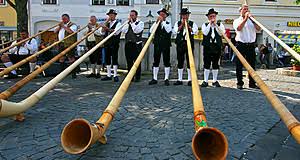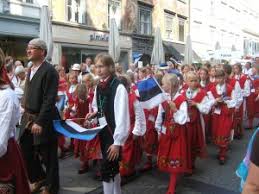source(google.com.pk)
Austrian Traditional Dress Biography
A dirndl [ˈdɪʁndl̩] is a type of traditional dress worn in Germany – especially Bavaria – Liechtenstein, Austria, and South Tyrol, based on the historical costume of Alpine peasants. Dresses that are loosely based on the dirndl are known as Landhausmode.
A dirndl skirt (sometimes spelled dirndle)[1] generally describes a light circular cut dress, gathered at the waist, that falls below the knee.
Description
The dirndl consists of a bodice, blouse, full skirt and apron. While appearing to be simple and plain, a properly made modern dirndl may be quite expensive as it is tailored and sometimes cut from costly hand-printed or silk fabrics. In the South German dialects (Bairisch), Dirndl originally referred to a young woman or a girl, and Dirndlgewand to the dress. Nowadays, Dirndl may equally refer to either a young woman or to the dress.
The winter style dirndl has heavy, warm skirts and aprons made of thick cotton, linen, velvet or wool, and long sleeves. The colors are usually rich and dark. The summer style is lighter and more frivolous, has short sleeves, and is often made of lightweight cotton.
Accessories may include a long apron tied round the waist, a waistcoat or a wool shawl. In many regions, especially the Ausseerland, vibrantly-colored, hand-printed silk scarfs and silk aprons are worn. As far as jewelry is concerned, women often sport necklaces, earrings and brooches made of silver, the antlers of deer or even animals' teeth. For colder weather there are heavy dirndl coats in the same cut as the dresses, with a high neck and front buttons, thick mittens and wool hats.
In popular culture it is sometimes reported that the placement of the knot on the apron is an indicator of the woman's marital status, with a knot tied on the woman's left side indicating that she is single, a knot tied on the right meaning that she is married, engaged or otherwise "taken", a knot tied in the front means that she is a virgin and a knot tied at the back showing that the woman is widowed.
History
The dirndl originated as a more hardy form of the costume we have today; the uniform of Austrian servants in the 19th century (Dirndlgewand means "maid's dress"). Simple forms were also worn commonly by working women in plain colors or a simple check. The Austrian upper classes adopted the dirndl as high fashion in the 1870's. Today, dirndls vary from simple styles to exquisitely crafted, very expensive models.
The dirndl is mostly worn in Austria and Bavaria. It is used as an everyday dress primarily by older women in rural areas. Other women may wear it at formal occasions (much like a Scotsman wearing a kilt) and during certain traditional events. It is hugely popular also among young women at the time of the Oktoberfest in Munich (and similar festivals in southern Germany, Austria, Canada, and the United States), although many young women will only wear dirndl-style dresses (called Landhausmode), which may deviate in numerous ways and are often much cheaper.
In Austria and Bavaria, the dirndl may often be seen on women working in tourism-related businesses, and sometimes waitresses in traditional-style restaurants or biergartens. It is also seen in these regions on women in the Volksmusik business.
The dirndl in Tyrol is a female dress copied from the Trachten, consisting of a top (Austrian: "Leibl") and blouse, wide skirt and a colorful apron. Originally, the dirndl was the working dress of female servants (Austrian "dirn": maid, maidservant); hence the term "dirndl" as an abbreviation of "Dirndlgewand" (maid's dress). Around 1870/1880, after Kaiser Franz Joseph made it fashionable to wear Lederhosen and Tracht, the upper classes adopted the dirndl as a modern dress and wore it on their summer holidays
Today the wearing of the dirndl is generally regarded as a sign of national pride; in material, color and shape it is increasingly subject to modern influences. The word dirndl also describes a young woman in many regional dialects of Austria.
rachten: Up to the 20th century, tracht (plural trachten) was, in the German-speaking countries, the general term for the kind or style of clothing and adornment (hairstyle, beard etc.) prescribed to identify a person as belonging to a particular group in terms of legal status (married, single), denomination, social standing or trade (miners, craftsmen).
As the urban bourgeoisie and aristocrats discovered nature and the charms of rural customs and living in the 19th and early 20th centuries ( Heimatkunst Movement), they triggered interest in preserving and cultivating the rural or regional styles of dress (Heimatwerk); today, the term tracht denotes any form of supposedly timeless traditional rustic dress.
Tyrolean traditional costume - Volkskunstmuseum in Innsbruck. Man from Landeck.
The trachten known today emerged through a combination of special regional dress features and the fashion of the day. The traditions of secluded regions and villages, proximity of major urban settlements, seasonal labour, hawking and the emergence of tourism all contributed to the preservation and further development of the concept of trachten.
Tyrolean traditional costume - Volkskunstmuseum in Innsbruck.
Since the 19th century researchers have distinguished numerous Austrian trachten regions, especially in the Alpine area. Basic common features were due to the availability of specific materials, such as linen, wool and leather, and of the facilities needed for processing them, and fashion trends of the 18th and early 19th centuries (once the authorities had relaxed the dress codes imposed on persons of different status).
The basic types include the "leibkittel" (a close-fitting sleeveless bodice with a full, gathered or pleated skirt) Dirndl with an apron, short or knee-length trousers made of deer or chamois leather, men's suits made of grey or brown cloth or loden with lapels in a different colour ( Steireranzug), ceremonial women's bonnets made of fur and bonnets or coronets of gold or silver filigree (Goldhaube). At present, there are numerous societies and clubs dedicated to the preservation and revival of trachten, with the result that most local costumes are of fairly recent origin.










Austrian Traditional Dress Biography
A dirndl [ˈdɪʁndl̩] is a type of traditional dress worn in Germany – especially Bavaria – Liechtenstein, Austria, and South Tyrol, based on the historical costume of Alpine peasants. Dresses that are loosely based on the dirndl are known as Landhausmode.
A dirndl skirt (sometimes spelled dirndle)[1] generally describes a light circular cut dress, gathered at the waist, that falls below the knee.
Description
The dirndl consists of a bodice, blouse, full skirt and apron. While appearing to be simple and plain, a properly made modern dirndl may be quite expensive as it is tailored and sometimes cut from costly hand-printed or silk fabrics. In the South German dialects (Bairisch), Dirndl originally referred to a young woman or a girl, and Dirndlgewand to the dress. Nowadays, Dirndl may equally refer to either a young woman or to the dress.
The winter style dirndl has heavy, warm skirts and aprons made of thick cotton, linen, velvet or wool, and long sleeves. The colors are usually rich and dark. The summer style is lighter and more frivolous, has short sleeves, and is often made of lightweight cotton.
Accessories may include a long apron tied round the waist, a waistcoat or a wool shawl. In many regions, especially the Ausseerland, vibrantly-colored, hand-printed silk scarfs and silk aprons are worn. As far as jewelry is concerned, women often sport necklaces, earrings and brooches made of silver, the antlers of deer or even animals' teeth. For colder weather there are heavy dirndl coats in the same cut as the dresses, with a high neck and front buttons, thick mittens and wool hats.
In popular culture it is sometimes reported that the placement of the knot on the apron is an indicator of the woman's marital status, with a knot tied on the woman's left side indicating that she is single, a knot tied on the right meaning that she is married, engaged or otherwise "taken", a knot tied in the front means that she is a virgin and a knot tied at the back showing that the woman is widowed.
History
The dirndl originated as a more hardy form of the costume we have today; the uniform of Austrian servants in the 19th century (Dirndlgewand means "maid's dress"). Simple forms were also worn commonly by working women in plain colors or a simple check. The Austrian upper classes adopted the dirndl as high fashion in the 1870's. Today, dirndls vary from simple styles to exquisitely crafted, very expensive models.
The dirndl is mostly worn in Austria and Bavaria. It is used as an everyday dress primarily by older women in rural areas. Other women may wear it at formal occasions (much like a Scotsman wearing a kilt) and during certain traditional events. It is hugely popular also among young women at the time of the Oktoberfest in Munich (and similar festivals in southern Germany, Austria, Canada, and the United States), although many young women will only wear dirndl-style dresses (called Landhausmode), which may deviate in numerous ways and are often much cheaper.
In Austria and Bavaria, the dirndl may often be seen on women working in tourism-related businesses, and sometimes waitresses in traditional-style restaurants or biergartens. It is also seen in these regions on women in the Volksmusik business.
The dirndl in Tyrol is a female dress copied from the Trachten, consisting of a top (Austrian: "Leibl") and blouse, wide skirt and a colorful apron. Originally, the dirndl was the working dress of female servants (Austrian "dirn": maid, maidservant); hence the term "dirndl" as an abbreviation of "Dirndlgewand" (maid's dress). Around 1870/1880, after Kaiser Franz Joseph made it fashionable to wear Lederhosen and Tracht, the upper classes adopted the dirndl as a modern dress and wore it on their summer holidays
Today the wearing of the dirndl is generally regarded as a sign of national pride; in material, color and shape it is increasingly subject to modern influences. The word dirndl also describes a young woman in many regional dialects of Austria.
rachten: Up to the 20th century, tracht (plural trachten) was, in the German-speaking countries, the general term for the kind or style of clothing and adornment (hairstyle, beard etc.) prescribed to identify a person as belonging to a particular group in terms of legal status (married, single), denomination, social standing or trade (miners, craftsmen).
As the urban bourgeoisie and aristocrats discovered nature and the charms of rural customs and living in the 19th and early 20th centuries ( Heimatkunst Movement), they triggered interest in preserving and cultivating the rural or regional styles of dress (Heimatwerk); today, the term tracht denotes any form of supposedly timeless traditional rustic dress.
Tyrolean traditional costume - Volkskunstmuseum in Innsbruck. Man from Landeck.
The trachten known today emerged through a combination of special regional dress features and the fashion of the day. The traditions of secluded regions and villages, proximity of major urban settlements, seasonal labour, hawking and the emergence of tourism all contributed to the preservation and further development of the concept of trachten.
Tyrolean traditional costume - Volkskunstmuseum in Innsbruck.
Since the 19th century researchers have distinguished numerous Austrian trachten regions, especially in the Alpine area. Basic common features were due to the availability of specific materials, such as linen, wool and leather, and of the facilities needed for processing them, and fashion trends of the 18th and early 19th centuries (once the authorities had relaxed the dress codes imposed on persons of different status).
The basic types include the "leibkittel" (a close-fitting sleeveless bodice with a full, gathered or pleated skirt) Dirndl with an apron, short or knee-length trousers made of deer or chamois leather, men's suits made of grey or brown cloth or loden with lapels in a different colour ( Steireranzug), ceremonial women's bonnets made of fur and bonnets or coronets of gold or silver filigree (Goldhaube). At present, there are numerous societies and clubs dedicated to the preservation and revival of trachten, with the result that most local costumes are of fairly recent origin.
Austrian Traditional Dress
Austrian Traditional Dress
Austrian Traditional Dress
Austrian Traditional Dress

Austrian Traditional Dress

Austrian Traditional Dress
Austrian Traditional Dress

Austrian Traditional Dress
Austrian Traditional Dress
Austrian Traditional Dress
Austrian Traditional Dress
No comments:
Post a Comment